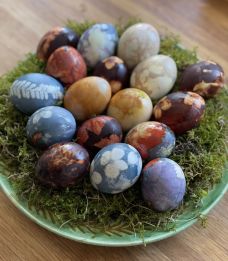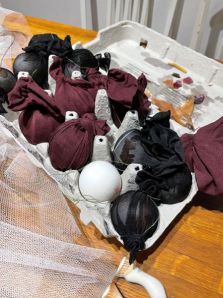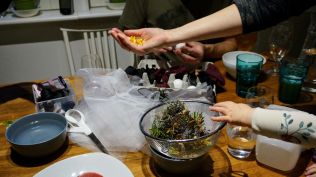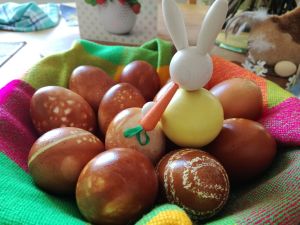The Latvian tradition of colouring Easter eggs
| The Latvian tradition of colouring Easter eggs | ||||
|---|---|---|---|---|
|
Practitioners and people who know the tradition well

The tradition of dyeing Easter eggs has been practised in Latvia for centuries. There are around 3000-5000 Latvians living in Finland. The Latvians still annually practise the egg colouring heritage. The tradition is practised at home with family members, and it could almost be described as a ritual to prepare for Easter celebration. Sometimes the tradition is presented to non-Latvian relatives and friends. Largely, preparation and decoration of the Easter eggs is widely carried out and actively practised mainly by female family members, especially the mothers of the family.
Practising of the tradition
The tradition of dyeing eggs for Easter is like a preparation ritual for the festivity and it touches every member of the family. Children are keen to participate as painting eggs is a creative and fun activity. Usually, it is performed the day before Easter and consists of several steps.
For the start, it is necessary to gather materials from surrounding nature and kitchen shelves. Mostly, mothers in the family are responsible for all the steps of the egg colouring custom. They collect materials that usually are ordinary items, such as small leaves, herbs, flowers, dried plants, rice or other grains, as well as threads and yarns. Furthermore, old thighs or cheesecloth are necessary to succeed, too.
Everyone can decorate their eggs themselves using and applying the materials they choose. Children always participate on this part, as it is a playful and innovative act. The eggs are covered with flowers, leaves and other materials, then wrapped into a piece of thin fabric and secured with thread. Later prepared eggs are carefully placed into kettles of natural dyes and brought to boil.
It is important that the decoction of natural dyes is prepared in advance. The most common colourant ingredient in dyes is the onion peel, which Latvians have traditionally used to dye eggs. Modern approaches involve making decoction out of red cabbage, turmeric, blueberries, or other ingredients that have been listed as good natural colourants. The last step of this ritual practice is to uncover the eggs and see how they turned out!

All in all, every family has their own ways or even secrets to practise and perform this heritage. The steps of the egg colouring process may vary and the used materials or approaches to decorate and wrap the eggs may be different. The time spent cooking eggs also varies: when to remove them from boiling water or how long to allow the eggs to dye. The Latvian families who practise this tradition admit that the dyeing of eggs is a competition comparing who has succeeded in making the most beautiful eggs. Nowadays it is important to take pictures of the eggs and share them with others on social media. Competitiveness has led to a lot of time and effort being devoted to finding the best and most advanced dyeing ideas for natural colourants and dyeing methods.
The background and history of the tradition
Easter eggs are decorated in many cultures around the world. This Easter celebration has a long history in Latvian culture. Easter is the festivity of spring solstice when the day and the night are the same length. This festivity is linked to the rhythm of the sun and the egg is associated as a symbol of the sun. Therefore, the eggs have always been in the centre for this festivity.
The egg colouring and ‘egg fights’ are the most common Easter traditions for the Latvian families. The egg colouring is an old and beloved custom for the Latvians and Easter is unimaginable without it. The word Easter, as in Christian tradition, in Latvian is Lieldienas and it means great-days. In old times, Latvians celebrated Lielā diena or the Great Day and this celebration was based on pagan habits. Through the centuries both, Christian and pagan customs have mixed. Nowadays, the celebration of Easter is a blend of these two traditions.
The transmission of the tradition

The practice of dyeing Easter eggs varies according to place of residence. The season and geographical location affect the possibilities to acquire material from both nature and local shops. The ways of dyeing eggs vary for these reasons, but on the other hand, customs also vary because people want to try new ways of dyeing eggs. They are searching for the latest trends and information on dyeing with natural dyes. Old traditional customs are combined with modern trends and are thus passed on to the next generations.
The most common method of sharing the knowledge of the egg colouring custom in the Latvian families is to experience it together. Every year the Latvian families prepare for Easter by decorating eggs. Annual tradition strengthens tradition and transmits knowledge about it to the next generations.
The future of the tradition

The habit of egg colouring for Easter is repeated in Latvian families every year. This heritage lives in almost every Latvian family. It has been suggested that the colouring of eggs is strongly linked to the Latvian food tradition: in general, the food culture has a significant role in Latvian culture. Decorated eggs are the main dish for the Easter celebration. Each family has its own methods and knowledge which are passed on by oral inheritance and by performing it together. Competence and know-how are shared during the creative process of preparing and dyeing the eggs. Children are involved in the process so that they can learn by actively practising and experiencing.
Combining traditional customs with more modern ways of producing colours would make the tradition even more attractive for some people. Because of the playful nature of the tradition, it is appealing to the youngest members in the families. This promotes the successful transmission from one generation to another one. Many Latvian families note that this is one of the Latvian traditions they love to keep alive and pass on for the next generations also living abroad.
The community/communities behind this submission
Latvialais-suomalaisten perheiden yhdistys Laivas ry
The article was born as part of the project of Ambassadors of Living Heritage in 2023 and was written by Vivita Kaupere
Bibliography and links to external sources of information
Online sources
Let the journey begin: Diary of trilingual family, Coloring Easter Eggs - Latvian Style
Latvian Public Broadcasting, How to colour your Easter eggs the Latvian way
Kerry Kubilius, Easter in Latvia: Springtime Holiday Traditions The Northern Vox
Rozentāls-seura - Suomi-Latvia-ystävyysseura, Pääsiäistä vietetään Latviassa ikivanhoin perintein
Mari Moilanen, Värjää kananmunat luonnonväreillä – raaka-aineet löytyvät jääkaapistasi! Iltalehti 9.4.2020
Lee Esselström, Munien värjääminen luonnonväreillä - näin helposti se onnistuu Yle 14.04.2014
Videos
Coloring Eggs for Easter - Latvian Traditions
Easter Egg Painting - very old Latvian method
Latvian traditions. Easter (in Latvian):
Latvian spring equinox (with English subtitles):LIELDIENAS
In Latvian
Mellēna, M., Muktupāvels, V., Spīčs, E. & Irbe, E. 2020. Gadskārtu grāmata (Year Book). Riga: SIA Madris
Easter. An article about Easter as spring equinox celebration tradition
Easter. Sisters, let’s colour eggs variegated. An article about Easter and egg colouring tradition
Egg colouring. Most common colourants that can be found in a household
